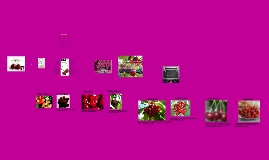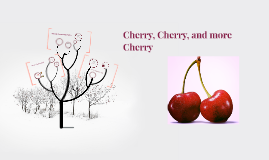Cherry♥
Transcript: cher·ry noun /CHerē/ cherries, plural A small, round stone fruit that is typically bright or dark red The cherry is one of the world's oldest cultivated fruits, along with its cousin, the apricot. Cultivation dates back to 300 B.C. and its lineage dates back even farther. The common cherry tree, Prunus avium, is native to the temperate areas of eastern Europe and western Asia and is part of the Rose family. Its name comes originally from the Greek, and in Latin means of or for the birds, due to the birds' obvious love of the fruit. The English word cherry originates from the Assyrian karsu and Greek kerasos. The tree was beloved by the Egyptians, Greeks and Romans both for its beautiful flowers and its versatile fruit. Although a different species of cherry was already strongly established in America by the time the first colonists arrived, the new settlers brought along their favorite European variety and eventually cross-bred the two. Today, 90 percent of the commercial cherry crop is grown in the U.S., mostly in Michigan, California, Oregon and Washington. The most popular variety is the Bing cherry, which was developed by Seth Luelling od Milwaukie, Oregon in 1875. It was allegedly named for his Manchurian foreman. There are now thousands of varieties of cherries and most are still picked by hand. Rainier Cherry It is oval shaped, with a beautiful bright attractive skin. Santinas came from the Canadian cherry breeding program in British Columbia in the 1960's. variety is a late cherry, with a unique taste and a firm fruit that is crunchy when picked and eaten. Protein A serving of wild cherries delivers 1.5 g of protein. Like most plant sources, these are incomplete proteins. They contain only some of the amino acids your body needs. To get a complete protein, you should also eat a food that provided complementary partial proteins. Cherry History Sweetheart Cherry How much is it? Cherries are sold in different types of packaging and the price can be different depending on the manner in which they are sold. If locally available, fresh cherries may be sold in your local grocery store. However, this is not always an option; this is why cherries are usually packed in bottles and cans since they usually come from another country. Depending on the time of the season, cherries can range from $0.99 to as much as $6 per pound. Carbohydrates Seventeen grams of the 22.4 g of carbohydrates in a serving of cherries come from sugar. Although not as unhealthful as raw table sugar, this does mean you should eat cherries in moderation. The remaining carbohydrates are made up of dietary fiber and complex carbohydrates. The dietary fiber helps clean your digestive tract, and the complex carbs deliver energy slowly over time. Santina Cherry Growth season Bing Cherry Lapin Cherry These sweet cherries are extra large in size, slightly heart-shaped cherries with a deep maroon color Cherries have a very short growing season and can grow in most temperate latitudes. Like most temperate-latitude trees, cherry seeds require exposure to cold in order to germinate (a mechanism the tree evolved to prevent germination during the autumn which would then result in the seedling being killed by winter temperatures). The pits are planted in the autumn (after first being chilled) and seedlings emerge in the spring. A cherry tree will take 3-4 years to produce its first crop of fruit and 7 years to attain full maturity. Because of the cold-weather requirement, none of the Prunus family can grow in tropical climates. The fruit is large, round and a beautiful deep ruby red color, and has a semi sweet flavor. Lambert cherries are usually available around the middle of July. Cherry Chef Hill HRM 140 Van cherries are a medium size fruit, slightly smaller than a bing, but are very firm black color, Made by yours truly ;) Vitamins and Minerals Cherries contain 16 percent of your daily vitamin C and 9 percent of your daily potassium. A serving also delivers smaller but appreciable amounts of vitamin A, vitamin K, thiamine, riboflavin, vitamin B-6, iron, magnesium, phosphorus, copper and manganese. Wild cherries contain no sodium. Lambert Cherry Cherry-Vanilla Layer Cake Maraschino Cake: 1/2 cup unsalted butter 1 1/4 cups granulated sugar 2 cups all-purpose flour 1 tablespoon baking powder 1/4 teaspoon salt 1/4 cup whole milk 1/2 cup maraschino cherry juice 2 teaspoons almond extract 2 tablespoons flour for sprinkling over diced cherries 10 oz bottle maraschino cherries, finely chopped Drop or two of red food coloring, or Americolor Deep Pink food coloring gel *optional 4 egg whites, beaten to stiff peaks Preheat oven to 340 degrees. Grease two 7” spring-form pans (or one 9”) and line with parchment paper. Beat the butter and sugar together in the bowl of a stand mixer until creamy. In a separate bowl, whisk together flour , salt and baking powder . Combine milk,cherry juice and almond extract, and add alternately to the butter and sugar with the

















